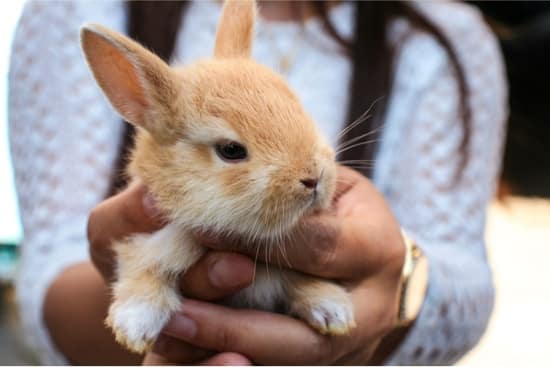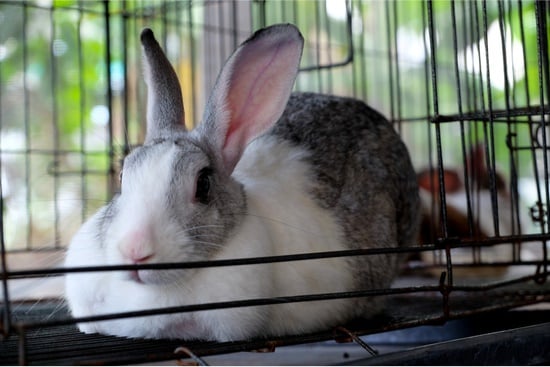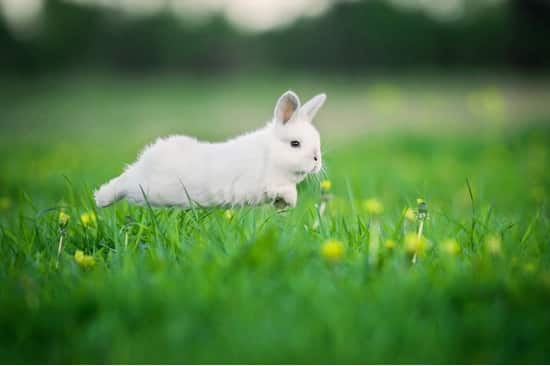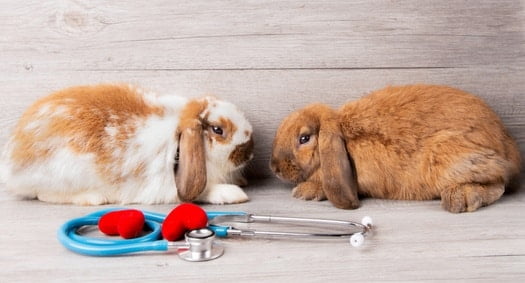Rabbits have become increasingly popular pets in recent years. But they can be difficult to look after because owners make incorrect assumptions about their day-to-day care needs. So, it’s vital that anybody who gets a bunny as a pet knows how to keep a rabbit happy and healthy.
Rabbits have complex digestive systems, so the right nutrition is essential. For example, Timothy hay will break down any excess calcium and prevent urinary stones.
Avoid feeding rabbits toxic foods like potatoes, bread, biscuits, rice, iceberg lettuce, etc. as these can cause sickness and illness. Your pet needs regular daily exercise, and will benefit from the company of a bonded second rabbit.
They also need intellectual stimulation to avoid sadness and depression. Spaying or neutering your rabbit, regular grooming, and keeping their hutch clean are also crucial.
With experience, keeping a rabbit contented becomes second nature to a new owner. Avoid making assumptions about what is right and wrong for your rabbit. Rabbits and humans have completely different requirements, and failing to acknowledge this could lead to an untimely demise.
How to Keep a Pet Rabbit Healthy
Rabbits are not always easy pets to care for. They can be demanding, and they have particular requirements. Thankfully, their love and companionship make all this effort worthwhile.
There are rules that you need to follow for appropriate rabbit care. If you take the time to learn more, your pet bunny will be a joy to be around. If you take chances, their health will suffer.
Let’s look at how you can ensure your rabbit enjoys a long and happy life.
1) Provide an Appropriate Diet
Food is the cornerstone of pet care, regardless of the species. So, ensure that you are providing appropriate nutrition. There are four cornerstones to your rabbit’s food.
- Pellets
- Hay
- Fresh vegetables
- Clean water
As your rabbit ages, their dietary needs will vary. Until a bunny reaches adulthood (at about seven months), they should eat alfalfa hay. This is high in protein, and will provide all necessary calories.
Hay must always be fresh. Change the hay in your pet’s hutch daily, as rabbits eliminate on it. If this sends the hay moldy, eating any mold can make your rabbit sick.
Beyond this, switch the alfalfa to timothy, oat or meadow hay. Alfalfa will be too calorific for adult bunnies, and lead to weight gain. Unlimited supplies if these other forms of hay should be provided.
Pellets are important to young bunnies, as they critical nutrients. Feed a baby rabbit unlimited pellets. Once the rabbit reaches adulthood, reduce pellets. If your adult bunny is indifferent to pellets, phase them out completely.
Fresh vegetables are a treat for rabbits, and introduce more nutrients to their diet. My House Rabbit lists recommended and suitable vegetables. As a golden rule, dark, leafy greens are best.
Concerning water, standard tap water is fine. Just ensure that your rabbit is drinking enough. Learn if they prefer a hutch-mounted bottle or a dish on the floor. Refresh the water at least once a day, ideally twice.
2) House Your Rabbit in an Appropriate Hutch
A hutch should be your rabbit’s home. This means that your pet should always feel happy in their hutch. This will keep your bunny safe from potential predators when they’re unable to run free.
The first thing to consider when investing in a rabbit hutch is the size. As we just said, this should be your rabbit’s home. A hutch is not a cage, and should never be treated as one.
Make sure the hutch is wide enough for your rabbit to stretch from the nose to toes, minimum. Your bunny should be able to make at least three hops before running out of space. They should also be able to stand on their hind legs comfortably.

Your rabbit will also need to have sufficient zones in their hutch. Rabbits are clean animals; they don’t want to eat or sleep where they eliminate. They’ll also want to undertake a range of activities and games in their hutch.
Remember, you can’t entertain your rabbit all the time. By ensuring they’re comfortable in their hutch, you won’t need to. A rabbit that enjoys their surroundings will patiently wait to be let out for play and exercise.
3) Maintain a Comfortable Temperature
While bunnies are hardy in the face of cold weather, they become uncomfortable when hot.
A rabbit should run a body temperature of 100 – 103 degrees Fahrenheit. Bunny fur sheds and grows according to the ambient temperature, so nature does most of the work. You’ll still need to vigilant, though. Rabbit Haven lists the symptoms of a bunny overheating as:
- Rapid breathing
- Lack of energy and vigor
- Heat around the tops of the ears
- Damp nose
Cold weather is rarely a problem. Most rabbits can cope with living outside all year round. They would experience worse in the wild, and they grow a thick winter fur coat.
Start to consider your rabbit’s safety if the temperature outside drops to 20 degrees Fahrenheit. You may wish to move your rabbit indoors. A garage is ideal, as long as your rabbit will still be able to breathe clearly.
Rabbits struggle with sudden changes in temperature. Don’t go from extreme cold to a home that’s warmed by central heating. This is arguably even more dangerous than entrusting your rabbit to keep themselves comfortable.
4) Spay or Neuter Your Rabbit
Spaying or neutering is a crucial element to rabbit health. Unless you are a professional breeder, get your bunny fixed. As long as you find a rabbit-savvy vet, the procedure is safe and straightforward.
Rabbits enjoy the company of their own species, and they’re never shy about congregating. Never assume that adopting two siblings means they won’t breed. Bunnies are not picky about partners.
Spayed or neutered rabbits are also much calmer than their unfixed counterparts. Bunnies are territorial by their nature. This can make them aggressive, and difficult to manage.
Fixed rabbits are likelier to live a long and happy life devoid of health concerns. The risk of urinary tract infections and cancer drops sharply after the procedure.
Most rabbits can be spayed or neutered once they reach four months. This is the time they become sexually mature, making the procedure important.
5) Keep Your Rabbit Calm
Rabbits are easily stressed. They are a prey species, and they’re acutely aware of this. As a result, it doesn’t take much to frighten a bunny.
This means that your pet needs to feel safe and secure at all times. You may find that your rabbit is reluctant to return to their hutch at night. If their hutch is comfortable, there is a safety concern.
Rabbits cannot see in pitch-blackness any better than humans. They can hear and smell well, though. This means that coyotes, foxes, and other predators in the yard will frighten them. Ensure your bunny always feels safe and secure when alone.
Sudden change, or a lack of routine, can also cause anxiety in rabbits. Get your pet into a strict schedule. Help them understand that they’ll be fed, exercised, and played with at particular times.
Just because rabbits cannot tell the time in the traditional sense, they do have a body clock. They’ll learn to expect certain activities at particular times, based on their routine. If you stick to this, they’ll be perfectly happy.
6) Ensure Your Bunny Gets Regular Exercise
Exercise is vital to rabbits. It helps them maintain a healthy weight, and it also keeps them happy. Rabbits have bags of energy, and staying in a hutch all day gets dull and frustrating.
The average rabbit needs around three hours of free-roaming each day. This should be divided into two sessions. One in the morning, when they’re most active, and again in the early evening.
The best way to get your rabbit exercise in the morning is to set up a playpen in the yard. Your bunny will need to be watched, as they can be master escapologists. Most often, though, rabbits will run themselves into exhaustion.
You should also attach a run to your rabbit’s hutch. This will provide a bunny will the opportunity to exercise at their leisure. It’s not as good as being free-range, but it’s better than nothing.

7) Toys and Intellectual Stimulation
Rabbits are smart, and they grow bored easily. They need to be kept entertained while in their hutch. Rabbits will be awake and active before you wake up, and after you go to bed.
Fill your pet’s hutch with as many different toys and activities as you can. This doesn’t need to involve trips to the pet store. A phone directory, for example, can provide hours of entertainment. Your rabbit will love shredding the pages. There are things that rabbits shouldn’t chew, though.
Vary and mix up the toys in your rabbit’s hutch as often as you can. Your pet will always be happier if they have new and unique experiences.
8) Ensure Your Rabbit Has Companionship
Rabbits hate being alone. They are sociable animals that live in substantial groups in the wild. This means they’ll become stressed and lonely in their own company.
Your rabbit will want to be the center of attention at all times. If you cannot provide this level of commitment, think twice about getting a bunny. They are not aloof or independent animals.
Rabbits are also much happier sharing a hutch with a fellow bunny. Just ensure that the two rabbits are bonded. Once this happens, they’ll be inseparable and perfectly content.
9) Clean Your Rabbit’s Hutch
Cleaning a hutch is a critical part of rabbit care. Your pet may not be happy about it, as they’re territorial. They’ll consider this cleaning to be an invasion of their space. It’s the only way to keep your bunny healthy, though.
You should give your rabbit’s hutch a full deep clean, with disinfectant, once a week. Use pet-safe cleaning materials for this, and return things as you found them.
In between, change your rabbit’s hay and litter every day. This is important, as mold is a silent killer of bunnies.
10) Groom Your Rabbit Regularly
Grooming is a vital part of any rabbit’s routine. Bunnies use grooming to determine their position within a social hierarchy. A submissive rabbit will groom a dominant rabbit on demand.
This means that your rabbit may demand to be groomed by you. This isn’t a problem. There is no harm in letting your rabbit feel like the boss of your house.
Grooming is a great way to bond with your bunny. They’ll enjoy the experience, and it will help you earn your pet’s trust. You may receive a lick while you groom your rabbit. This is your bunny saying, “thank you – I love you.”
Grooming is also essential for a rabbit’s health. Bunnies are meticulously clean by their nature. If you notice that their fur is off-color or matted, something is wrong. Take this seriously, as no rabbit willfully neglects their cleaning routine.
Do not bathe a bunny unless strictly necessary, as they find this traumatic. Wherever possible, clean up your rabbit with a flannel doused in warm water.
You must take action of you notice urine stains on your rabbit’s fur. If left too long, these can cause urine scalding (wet tail), a painful condition. Rabbits may accidentally pee on themselves, or sit in their litter tray.
Pay attention to your rabbit’s bottom while grooming, too. Rabbits must always have a clean rear. A messy bottom invites flies which, in turn, leads to flystrike. This is a devastating, and usually fatal, condition for rabbits.
11) Check Your Rabbit’s Teeth
In addition to their fur, you should always ensure that a rabbit’s teeth are healthy. Bunny teeth never stop growing, and this can cause discomfort. If your rabbit has dental pain, they won’t eat. This can quickly become dangerous.
If your rabbit eats an unlimited supply of hay, their teeth should be fine. A high fiber diet is pivotal to oral health in bunnies. Munching on hay will keep their teeth filed.
Take a look at your rabbit’s teeth at least once a week. They should be white, smooth, and the top and bottom rows should meet neatly. If this is not the case, have your rabbit investigated by a vet. They may need their teeth filed down.
12) Vaccinate Your Bunny
One of the first steps that a new rabbit owner should take is arranging appropriate vaccinations. This only applies to particular territories, though.
In the USA, there are no formal vaccinations for rabbits. You can still purchase them, but they are not a legal requirement. This is because the USA has a small native rabbit population. Bunny-centric disease outbreaks are rare.
In other countries, there are two core vaccinations highly recommended to rabbit owners:
- Myxomatosis – This contagious viral disease is incurable, and invariably fatal. Outbreaks are rare in the United States as wild bunnies have developed immunity. It’s a substantial problem elsewhere, though.
- Viral Hemorrhagic Disease – This disease spreads like wildfire, and humans can carry it without displaying symptoms. It usually kills rabbits before they can even be diagnosed.
When you arrange to bring your rabbit home, discuss potential vaccination needs with an expert. Doing so may save their life.

13) Undertake Annual Healthcare Checks
Rabbits are prone to health concerns. They are also adept at hiding pain and discomfort. Often, a bunny owner only realizes that there is a problem when it’s too late to rectify.
One way around this is to arrange annual healthcare checks for your pet. Find a rabbit-savvy vet in your area. This is important, as not all vets are familiar with the unique ailments of this animal.
If you get your rabbit assessed at least once a year, any potential problems will be diagnosed early. Your bunny’s weight will be checked, their teeth will be evaluated, and tests can be run.
Prevention is always better than cure where rabbits are concerned. Their small and frail bodies can struggle with major surgery. If treatment is administered early, they’ll remain healthy.
14) Rabbit-Proof Your Home
Your rabbit will be part of the family. As a result, they’ll likely run free for several hours each day. You have a duty of care to ensure they are safe while they do this. Common concerns that must be addressed include:
- Escape Routes. Rabbits are curious creatures. They may squeeze through the smallest holes in a garden fence. Block any escape routes. Domesticated bunnies cannot survive in the wild.
- Electrical Cables. Cables are irresistible to rabbits, who love nothing more than chewing on them. This is dangerous. Not only is your bunny at risk of electrocution, but they can start a fire.
- Other Pets. If you have a cat, ensure they understand your rabbit is not a snack. It may be best to keep the animals separate until they understand each other.
- Soft Landings. Rabbits love to climb and jump. This can lead to leaps from height, risking a severe injury. Place blankets and pillows around the furniture to provide your rabbit with a soft landing.
Rabbit-proofing a home is just as important as baby proofing. If a bunny can get into trouble, they probably will. Take the time to minimize the risk.
15) Handle Your Rabbit with Care
Handling a rabbit is a critical skill, and it must be done right. As cute and cuddly as they are, many bunnies do not like being picked up. They feel trapped and frightened, and may try to escape.
Having said this, handling a rabbit is sometimes essential. You’ll need to scoop them out of their hutch for cleaning if they’re reluctant to leave. You’ll also likely need to pick up your pet to transport them to the vet.
Never pick up a bunny by their ears, legs, or the scruff of their neck. To handle a rabbit:
- Keep the bunny calm by offering some gentle petting.
- Get down to the rabbit’s level. Scooping up a bunny from a standing position will terrify them. Birds of prey are a common rabbit predator.
- Place one hand under the rabbit’s chest, and the other under their rear end. This will create an even distribution of their weight.
- Lift the rabbit into your chest. Hold them close enough that they cannot escape, but not so tight that they panic.
- Put the rabbit down immediately if they show any signs of distress.
Handling – and the distaste that many bunnies have for it – is something that must be considered. This fear of handling is why rabbits are not always suitable pets for children.
Rabbits can be seriously injured if they are dropped, and can be squirmy while being handled. They may also nip, bite, or kick to avoid being picked up. If you have children, ensure they understand how delicate a bunny is.
16) Listen to, and Understand, Your Bunny
Rabbits have a reputation as quiet animals as they don’t bark or meow. Rabbits do communicate with humans, both verbally and physically. Essential verbal tics to listen out for in bunnies include:
- Grunts and Snorts. These mean that your rabbit is not happy. You may hear these sounds while handling them, or cleaning their hutch.
- Tooth Clicking. This is a sound similar to a feline purr. It means that your rabbit is happy and content. You’ll often hear it during petting or grooming.
- Tooth Grinding. This is an important distinction from tooth clicking. Grinding their teeth means that your rabbit is in pain, and needs medical attention.
- Honking. If you hear this sound coming from an unfixed rabbit, keep them away from fellow bunnies. Honking denotes that a rabbit is looking to mate.
In addition, understand your rabbit’s body language:
- Binkying. If your rabbit is running in circles and jumping on the spot, they’re over the moon. Keep doing whatever sparked this reaction.
- Flopping. If your rabbit suddenly flops onto their side or belly, they’re relaxed. This is often seen after a long playtime or exercise. The rabbit is shattered, and is ready for a nap. Pet rabbits don’t always want to play.
- Flipping onto Their Back. This means that your rabbit is terrified. Back away, and give them peace. They’re playing dead in the hope of being left alone.
- Nudging. Rabbits often nudge humans with their nose. This is a plea for attention. It typically means, “pet me, please” – or sometimes simply, “you’re in my way.”
- Chinning. Rabbits have sweat glands under their chin. They rub their chin on items to claim them as their own.
The House Rabbit Resource Network provides more insight into rabbit language. Learn their cues well and you’ll get along well.
17) Prepare for a Long Commitment
Remember that a happy, healthy rabbit is a long-term commitment. You may have read that rabbits only live around two years. This is true of wild bunnies. A well-cared-for domestic pet can live as long as a decade.
Prepare yourself for ten years of caregiving and expenses. Rabbits take time and money to keep healthy. As they age and reach different stages of their life cycle, bunnies also have differing needs.
If you’re prepared to accept this, your rabbit will live a long and happy life. They’ll provide many years of wonderful companionship in the process, too.

